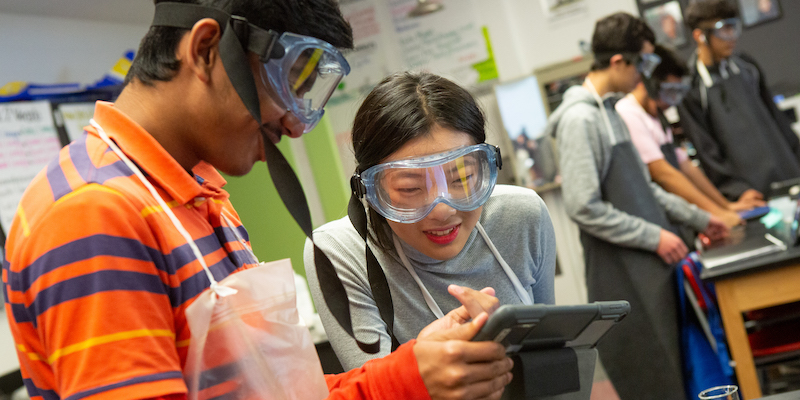Redesigning high school: it’s been a popular idea for decades in education reform, with initiatives ranging from Ted Sizer and the Coalition of Essential Schools to the high-profile XQ Super School project.
As people consider various high school reforms, the Canopy project gives a valuable glimpse into the innovations underway at a diverse set of high schools across the country. The project produces a national dataset on innovative schools and asks those school leaders to report their practices using a consistent set of keywords or phrases (“tags”). At least 114 high schools are represented in the dataset.
Last year, our analysis suggested that a subset of student-centered practices are more associated with high schools than with schools at other levels. Now, we dig in further to investigate additional patterns in high school innovation.
The innovative practices most common in high schools
One angle for looking at high school innovations is to consider which practices are reported by high school leaders more than those in elementary and middle schools. It turns out that many of the practices most commonly reported by high schools (compared to non-high schools) are intuitive, such as dual credit (when students can earn college credit while in high school) and early college high school (schools that are a hybrid of high school and college, where students take high school and college classes simultaneously). Some career-oriented practices, like career training and prep or students earn industry credentials, also appeared more frequently in high schools.
But it’s worth noting that some practices that seem appropriate for learners of all ages were also more commonly reported by high schools. Project-based learning and competency-based education, typically discussed as important phenomena across the K–12 spectrum, turned out to be reported more often in high schools. Additionally, students of any age can benefit from meeting professionals from different fields, but 45% of high schools reported that students meet industry professionals compared to 25% of non-high schools. And community and business partnerships, which can help schools of any level facilitate experiential and real-world learning, showed a 17-percentage-point difference between high schools and non-high schools.
Types of practices associated with high schools in different locales
With over 90 tags in the Canopy dataset, it can be hard to spot broad trends when looking only at isolated practices. So, we set out to understand what types of practices tend to appear in high schools in different contexts, like schools with different demographics, size, and locale. (For the quantitatively-inclined, we identified clusters of practices in high schools using an exploratory factor analysis, then looked for correlations between those clusters and contextual variables like school demographics, size, and locale.)
The most notable trend we noticed when comparing the practices of high schools from different contexts was that locale (urban, suburban, or rural) appeared to be associated with high schools’ likelihood of reporting different types of practices.
First, urban high schools were strongly associated with a cluster of equity-oriented practices, exemplified by tags like social justice focus, hiring prioritizes equity-focused values, culture of anti-racist action, and practice of culturally relevant pedagogy. (High schools serving higher proportions of students of color and students qualifying for Free and Reduced-Price Lunch were also more strongly associated with this equity-oriented cluster of practices.)
Second, urban high schools were positively associated with a cluster of practices themed around individualized and tech-enabled instructional models, exemplified by tags like students progress at own pace, individual rotation (a model of blended learning), individual learning paths, and interoperable data from multiple technologies.
Third, urban high schools were again positively associated with a cluster themed around deeper learning and inquiry-based instructional models, exemplified by tags like performance assessment, project-based learning, real-world problem solving, and interdisciplinary.
On the other hand, rural high schools were negatively associated with the same three clusters of practices that appear more common in urban high schools, especially the cluster of equity practices. (This supports our recent finding that locale was the strongest predictor of the presence of certain equity-focused practices across all schools in the dataset.)
Additionally, we had hypothesized that school size might be another place where we’d see differences in practice, such as project-based learning practices appearing more commonly in smaller schools. But in this particular analysis, that hypothesis didn’t bear fruit: school size wasn’t very strongly associated with any cluster of practices, except for a slight negative association between larger schools and equity practices.
Two recent glimpses into what high school can be
To complement the broad trends we discovered across the Canopy dataset, recently, my colleague Tom Arnett and I dug deeply into two innovative high schools that we learned about through the Canopy project. In partnership with the Center on Reinventing Public Education (CRPE), we studied how two New England schools navigated the pandemic year, each representing a very different approach to reimagining high school.
- Common Ground High School in New Haven, Connecticut, is a single-site charter school that sits on 20 acres of land and houses an urban farm that produces more than 10,000 pounds of local food each year. Students are encouraged to become local changemakers by serving the community and driving their own educational experience. Our school profile describes how the school has made student voice and leadership not only a philosophy, but an operational principle through key strategies.
- Map Academy in Plymouth, Massachusetts, now in its second year of operation, is designed to work for students for whom conforming to the traditional K–12 education system is not always compatible with their life circumstances. Our school profile shows how the school provides an education that adapts to the needs and interests of its students while maintaining high expectations.
Despite these differences in context and focus, both schools report many of the practices listed above that appear more often in high schools than elementary and middle schools. Common Ground, for example, cites extended learning opportunities and individual learning paths as two of the five practices that are central to its approach, and Map Academy reports competency-based education as a central approach. Both schools—Common Ground in an urban locale and Map Academy in a suburban one—also report a number of equity-focused practices, such as practice of culturally relevant pedagogy and elimination of tracked classes.


